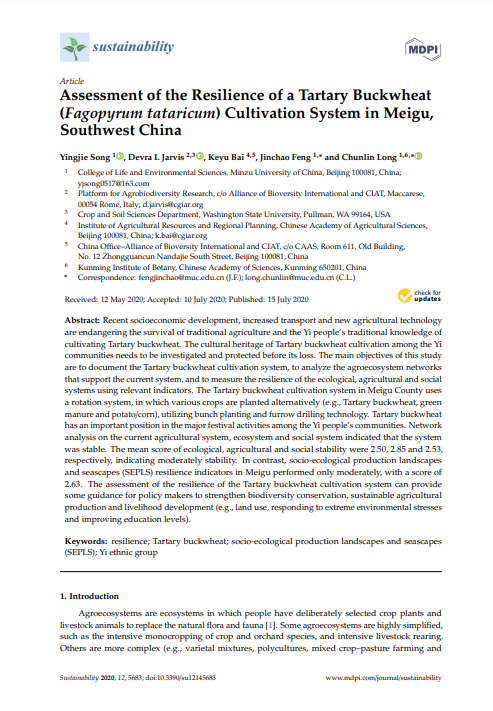![]() Recent socioeconomic development, increased transport and new agricultural technology are endangering the survival of traditional agriculture and the Yi people’s traditional knowledge of cultivating Tartary buckwheat. The cultural heritage of Tartary buckwheat cultivation among the Yi communities needs to be investigated and protected before its loss. The main objectives of this study are to document the Tartary buckwheat cultivation system, to analyze the agroecosystem networks that support the current system, and to measure the resilience of the ecological, agricultural and social systems using relevant indicators.
Recent socioeconomic development, increased transport and new agricultural technology are endangering the survival of traditional agriculture and the Yi people’s traditional knowledge of cultivating Tartary buckwheat. The cultural heritage of Tartary buckwheat cultivation among the Yi communities needs to be investigated and protected before its loss. The main objectives of this study are to document the Tartary buckwheat cultivation system, to analyze the agroecosystem networks that support the current system, and to measure the resilience of the ecological, agricultural and social systems using relevant indicators.
The Tartary buckwheat cultivation system in Meigu County uses a rotation system, in which various crops are planted alternatively (e.g., Tartary buckwheat, green manure and potato/corn), utilizing bunch planting and furrow drilling technology. Tartary buckwheat has an important position in the major festival activities among the Yi people’s communities. Network analysis on the current agricultural system, ecosystem and social system indicated that the system was stable. The mean score of ecological, agricultural and social stability were 2.50, 2.85 and 2.53, respectively, indicating moderately stability. In contrast, socio-ecological production landscapes and seascapes (SEPLS) resilience indicators in Meigu performed only moderately, with a score of 2.63. The assessment of the resilience of the Tartary buckwheat cultivation system can provide some guidance for policy makers to strengthen biodiversity conservation, sustainable agricultural production and livelihood development (e.g., land use, responding to extreme environmental stresses and improving education levels).
Song, Y.; Jarvis, D.I.; Bai, K.; Feng, J.; Long, C.

